#I have done a custom through Dropbox so if anyone is interested I’m sure I could be persuaded 😝
Explore tagged Tumblr posts
Text
QUESTIONS AND ANSWERS AND DEVELOPMENT UPDATE ROUNDUP
We’ve gotten a number of questions from our Discord members in the past month and it’s time to share them with everyone along with our answers.
See what a handful of our backers have been asking Rob, Aivi, surasshu, and me after the jump.
Kishou asks the following questions:
Can you change Esmy's appearance? Like, with armor sprites?
Sadly, given how Cryamore’s sprites are designed, it’s too taxing to make armor sprites for Esmy as we’d have to make armor sprites for a lot of unique animations, idle, running, hit, ground cast, mid cast, high cast, Vanish animations, Boulder Dash animations, etc. and then multiply that with 3 or 5 directions each.
The most we can offer for visual customization are palette swaps.

Featured above are palettes for default, Braxton, Bliss, “Dewritos”, and Black & Blue
I just want to see Esmy in something revealing like a swimsuit
Rob can probably arrange that in another artwork. I could sprite Esmy in a swimsuit but I don’t think we have any scenarios written down that feature her in one.
Of course, we could always write one in...
I'm not sure if this is asked before but is there a love interest in mind for Esmy?
Esmy’s too focused on her work and studying cryamore to notice anyone that may have feelings for her.
Right?

There's no "right" or "wrong" way to clear the game right? Like, surely some spells solve puzzles but there will be proficiency in not just weapon choices but spells in fighting too?
We’ve done our best to make sure your offensive/defensive ability and weapon loadouts will always be viable so whether you like playing ranged weapons with hard hitting close combat abilities, using mobility enhancing abilities with melee weapons or whatever playstyle tickles your fancy, we’ve spent a lot of time ensuring we got everything balanced and fun enough so there won’t be an absolute god tier and worst tier loadout.
Phosphatide asks:
About story flow: with games now searching for the perfect balance between "linear progression" and "open world freedom" to avoid blatant in-game walls preventing the possibility of sequence-breaking exploration or aimless wandering with no sense of urgency... what was your goal for Cryamore?
Alan: Honestly, I personally wanted full-on freedom to go explore some of the hardest areas of the game and risk the chance of getting wrecked, but we had to corrall things a bit to ensure you stay within the story bounds. Rob being the lead on this has final say on direction.
Rob: I wanted to instill a sense of survival in the game and make sure that the abilities are a big focal point for both puzzles and combat so we were able to block off certain areas of the world the way Metroidvanias would; give you a hint at what might be ahead, but you're blocked by something that needs a new ability
Alan: There's still freedom to be had but you can only go so far before you either hit a roadblock which needs an ability or sometimes story progression (you need clearance to explore south of the island)
So yeah, the goal was to give some freedom but not too much and I'm hoping we managed to achieve it with the world design I've done and with enough usage of the puzzle solving abilities we've made.
Tomar asks:
Curiosity here. Do you guys do art asset sharing through your VC system, or do you use something simpler like dropbox/google drive?
We’ve mostly used Dropbox all throughout to share asset files.
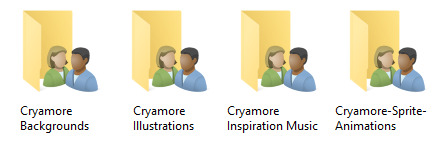
Above are the four folders we have set for Cryamore. Backgrounds has Rob and me contributing to it, Illustrations has Rob, me, and JC and Juby’s contributions, Inspiration Music has Aivi and surasshu’s work (a lot of unheard of to the public music WIP files) and Sprite-Animations has my work.
Once something like music, animation or an environment asset is set, Rob or I transfer it to Unity, apply any settings necessary (import and display settings for 2DToolkit, audio settings for Master Audio, etc.) and then upload it to the SVN so the file and all its settings will exist for anyone on the team with a Unity key and access to the Cryamore SVN.
Do you use freecamp for like kanban/task management stuff?
When we had more people in our team, we used OpenOffice and then switched to Freedcamp to keep track of tasks and bugs. Now that it’s just Rob and me, and Aivi and surasshu on sound and music, we mostly just keep a personal to-do list.
Xaelon asks:
I have no idea if this is possible with how the game is built, but something you could add to promote replay after the base game is completed would be a "randomizer mode" that shuffles various things into different places.
We could probably apply that to enemy spawns and some cryam deposits but the environment layouts though aren't as flexible sadly as we don’t use tilesets and the collision bounds of the environments aren’t generated by object due to a lot of irregular organic shapes.
We definitely have considered implementing a NG+ option though, maybe with levels and certain abilities intact on the next play but with more mobs and other difficulty boosts.
shadowreaper5 asks:
Do skills with timers (like the buff to breathe underwater) have a visual representation of the time left?
To a certain extent, yes. Esmy’s going to have a breath meter over her head while underwater without the Oxy Barrier ability.
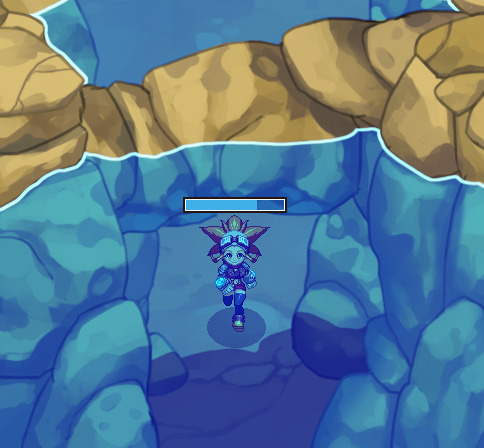
We initially wanted to just have a blue fill over Esmy’s status portrait (which changes to her holding her breath) while underwater but so it’s easier to keep track of, she’ll have a meter above her head when she isn’t using Oxy Barrier underwater.
While we do have spells with durations, some of them won’t have a meter and rely on visual cues: a timed magma mine will blink when it's about to explode, time paradox clones should blink when they're about to fade, and shadow cloak should fade back to full visibility upon ending. As it is though, we will mention the duration of spells in their info box at the menu.
Tarquinn2049 asks:
Ok. This question is a bit on the other end amd might make me sound like a jerk due to timing. But does it support 4k? And if so is it by pixel doubling? I can totally play it at 1080p if hardware scaling will ultimately look better.
Our native resolution is 720p which we’ll be upscaling to 1080p. We won’t be able to provide 4K support as working primarily in 2D where our target resolution is 720p would require us to rework the assets in a larger size so as not to lose crispness of lines and pixels on a larger resolution.
Rob: The game looks freaking good on a 50-70 inch, though haha! I for one can't wait to playtest a lot on console (devkit).
DEVELOPMENT UPDATES
Unity editor-wise, Rob has been working on optimizing the code further. The sorting order of the game was archaic and clunky, so Rob decided to squish it down to a simpler and more effective form that relies on Sorting Order that Unity didn’t have early on during our development. We instead relied on Z index which required a lot of fiddling around with when setting objects up.
youtube
You can see in that test room video that the “Order in Layer” is changing value. Back then it would be the Z in the Position attributes and we’d have to manually set the value beforehand to make sure things appeared behind or in front of objects right.
youtube
Rob also implemented full analog movement instead of just the D-pad, this allows for more control, though it’ll need a bit of tweaking as it currently looks like Esmy’s skating along the ground like she’s about to break it down and provide everyone with boosted shields.
There’s been polish going on in multiple fronts on the graphical end as animations and environment assets get fixed.

Above is the fist weapons, we initially were going to go with brass knuckles but decided that it wouldn’t be that noticeable on the sprite unless we made it large but I wanted to make sure you wouldn’t miss the weapons so I designed these gauntlets that shows a bit of the transition from steamtech to cryamtech and also offers a more interesting silhouette while also making a bit more sense as a viable weapon against dangerous monsters.
The fists primary function work as a mashable combo. One press of the attack button does a jab, two presses in quick succession performs a jab and punch, three does a jab, punch, uppercut combo. It’s quick but it doesn’t have that much range or width in its melee attack range.
The second function is the parry which allows you to negate any damage if timed right. Rob’s in charge of securing the timing for all these as he’s the one in Unity and more well-versed with the parrying system this was inspired from (Street Fighter 3) so I trust he’ll make sure it’s balanced. We wanted to make the fists fun to use but even better if you master it and hopefully it’ll show.
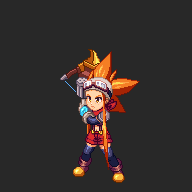
The crossbow also underwent an animation rework during its polish phase. The old animation was too focused on being realistic that it didn’t look interesting (i.e. it looked too slow) and the crossbow already has it tough in being interesting when up against the pistols. So far everyone feels it looks much snappier now while still keeping to the timing of the old animation.
What differentiates the crossbow from the pistol is that Esmy can hold her shot and slowly strafe while doing so, only firing when you let go of the attack button. The crossbow also has different types of bolt quivers that you can equip. Currently we’re playing around with piercing properties and stagger/slowing/knockback properties.

We’re also looking into displaying the ammo/bolt count below Esmy everytime she fires so the player can easily keep track of their shots (we’ve been running on infinite ammo all this time just to get a feel of the weapon first before applying a limit).

The rapier’s animations will still need the pixel pass but its roughs are ready.
You’ll notice two phases in the rapier animation. The basic thrust and the secondary backdash. These are the primary and secondary functions of the weapon. One allows you to dash forward with a piercing strike and another for quick evasion, making the rapier a weapon all about mobility (which could be handy for speedrunning too).
The Ghilcrest buildings are undergoing their design polish as well. You’ve all seen the Cryatisium and Esmy’s Home and now the Inventorium and the Cafe are joining them in polished goodness.


The overworld environments have also been undergoing its rework. More unique object assets have been made and its design is now following the Overworld map that I completed.
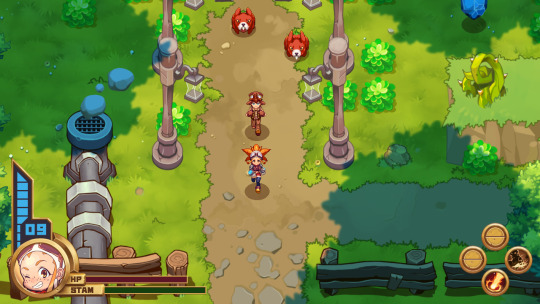
Worry not about the above image. Though we do have Brax (and some other characters) following you at some points in the game, it’s not a dangerous escort mission where you’ll have to struggle to keep your companion alive, the Berribuns were added on the map just for this screenshot (they ignore Brax and only go for Esmy).
I’ve tried to incorporate hints of the past steamtech throughout areas of Noka Island that the settlers covered, some machines like the one on the screenshot above were retrofitted to use cryam instead of steam (I did receive comments on how the smoke blobs look more like rocks so I’ll probably change it to wispy smoke).
The HUD has also undergone a visual polish to make it look more bronze plated to go with the early post steampunk-ish feel.
I’ll be continuously working on more animations and environment asset polish all throughout while Rob cleans up code, works on other background assets or lays said assets out in the Unity editor.
ART SPOTLIGHT
Every now and then, Rob (and sometimes I) take a breather and make some art (which will all eventually end up in the artbook) so here’s some of the choice pieces as of late.

Rob made something that could be wallpaper material once he cleans it up in a higher res, it’s an array of Bliss in a custom outfit.

Another wallpaper-ish piece from Rob with Deseret, Bliss, and Sorbet looking all tough and showing what I’ll just assume to be Ghilcrest gang signs... despite it being a small community.

Here's a more realistic pin-up style Bliss that Rob also made.

Rob also pays tribute to Atlus’ Persona and Shin Megami Tensei series by rendering Esmy in Shigenori Soejima’s style.
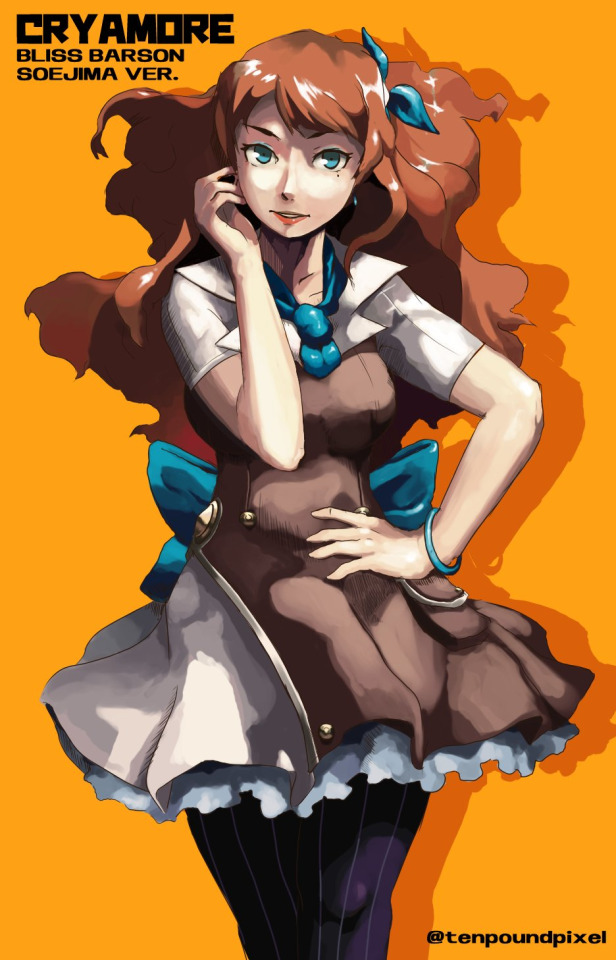
I did the same and tried making a Shigenori Soejima tribute using his soft paint style commonly present in Stella Deus and some Persona art. I chose to represent Team Bliss.
COMMUNITY SPOTLIGHT
We’ve also got a few new submissions of fanart from the community that we’re proud to share with everyone. We’re grateful to have all your support and enjoy seeing everyone’s renditions of the Cryamore cast.

@Cliffist pays tribute to the fab queen, Bliss because clearly, she’s supposed to be the star.

@boss_ruru also decides to rep Team Bliss with this lovely piece of Ms. Barson in one of her many alternate outfits.

But it’s not all Bliss as MellowMarz aka @HeartlessHat provides a pistol toting pixel-art Esmy.
I’ll be working on the pixel art and animation featurette next. I had to hold it off since I needed to prep this first.
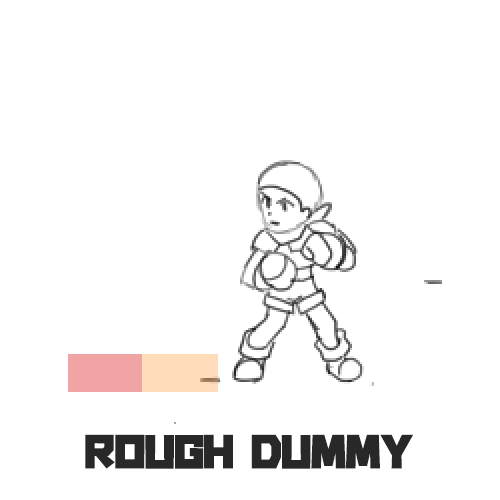
It should give an idea of what the update will cover.
I hope you enjoyed this update and all the news! Thanks for taking time to read through these.
- CM Alan
P.S. I also managed to secure one of the previous builds we made and will be preparing a guide to go with it for the backers on Discord.
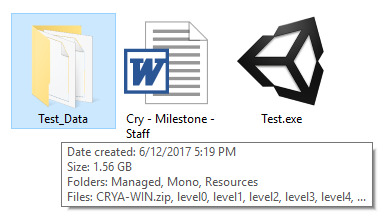
28 notes
·
View notes
Link
Back in the early 2010s, when I was still an active songwriter and radio jingle/ads producer, I lived remote enough that it was hard for me to find local session musicians for hire when I needed live instrumentation or a certain vocal type. Through Craigslist, other classified ads and Mylene who is our co-founder and back then managed touring musicians, I put together a small team of essential session players. We pretty much communicated by email, phone, dropbox and the likes. Since that was rather time consuming and not very efficient, we more or less hacked together a collaboration tool. Since I knew other songwriters I told them how I create my music and they asked me if I can help them as well and that’s when Tunedly became a business. That was in 2015 and we officially incorporated in 2016 making a run at it.How much we invested initially is hard to quantify because it's not like we moved funds from one account to another account and decided it would be our "startup fund" or the likes. I left a well paid job as a manager to work full time on Tunedly, without having any reliable income from Tunedly at that point. So, we lived partially from savings. Then, once we noticed this is going somewhere, we permanently immigrated from Europe to Canada so that we can fundraise in the U.S. and Canada, attend accelerators in the U.S. and live in North America full time. Going through the immigration process, as you can imagine, wasn't cheap. If I have to guesstimate how much we invested initially prior to our first outside investment, I would say somewhere around $20,000.What does Tunedly do?When we started, we were a pure collaboration tool, connecting songwriters to vetted session musicians. By now, we are more of a music publisher. We still operate the collaboration platform, but that really only serves as our source of content. We noticed this: On our platform, there are thousands of new songs being created every year. Songs nobody has ever heard and we get a first pass at them. So, when we come across a song that sparks our interest and could be commercially viable, we make an exclusive publishing offer to the songwriter and then try to place the song in film, TV, ads, media or with established artists, which generates sync license fees and royalties for us and the songwriter.For this company, it was a gradual decision to start. I mean, myself and Mylene were already entrepreneurs prior to working on Tunedly so it wasn’t like we just decided to be self employed. However, the way Tunedly developed and became a company was gradual. I was really just trying to find a way to be more efficient for my own songs and noticed by helping me, we’re actually creating something of value to the music industry.How did you get your first three clients?By talking to other songwriters. It really was that. I was in touch with a number of other writers through online forums where I shared music to get feedback, they shared music to get feedback and at the end of the day, I was asked often enough “how do work with your musicians?” and that’s how we found our first three “clients”. Funny enough, our very first client, when Tunedly wasn’t even called Tunedly yet - we didn’t have a name at that point, is still with us today. He has been with us for so long, it almost feels like he’s part of the company. He really experienced the growing pains as much, if not even more severe as we did as founders. He got so used to just talking to one person, being myself, when getting his songs done. As we grew and added more staff, at times I couldn’t be involved in music production projects due to travel, fundraising, presentations, etc. so he had to deal with staff and at first he wasn’t all too happy about this, but at the end of the day, he is still with us because the quality of session musicians and production quality at our rate is impossible to get elsewhere.When we had that “oh, this could be a business” moment, we put up some ads on Google, bought a few banner ads on songwriters forums and things like that just to see if we can attract songwriters who we don’t personally speak to. Sure enough we could.I have been into music since I was nine years old. I learned how to play the piano and then in college I picked up songwriting and music production, so I had experience in the area.Have you raised any money? How much?We have raised some angel funding. After we validated the market, we went through two accelerator programs, StartFast in New York State and then Capital Innovators in St. Louis. The funds they invested plus the exposure they gave us to other investors in their network enabled us to raise a total of about $500,000.The initial idea was funded by personal savings.How do you attract clients?In the early days, we worked a lot with paid advertising on Google and Facebook. Nowadays our blog is generating most of our traffic, plus we get into news articles every now and then which keeps us on top of songwriter’s minds.Our target audience are songwriters. If you had asked me this question a year ago, before we really got into the publishing side of things, the answer to this question would have been much longer, but today, we really just want to make sure we’re working with songwriters who either want to create great sounding songs, or already have great sounding songs which we can sign to a publishing deal.What is the funniest/most strange request you have received from a client/prospective client?There are so many funny and strange requests, I’d really have to think hard about which one tops the list. I think the funniest and strangest song we ever worked on was a Psychedelic song about a purple house, written and composed by a talented songwriter in India. Other requests that were strange at first was when people who are not songwriters came by asking us to write a song for them for a special occasion or a birthday. I mean, we were always very clear about the fact that the platform is for songwriters but since this request came up repeatedly, we actually launched a service under a different brand at Bring My Song To Life to cater to those requests.Where did you meet your founding team?Mylene and I met about two years before we founded Tunedly while we both lived in Dublin, Ireland and actually became a couple. We met Marc, who joined us shortly after we founded Tunedly as the CTO, in New York while we were in the StartFast accelerator program. Neither Mylene nor I have a technical background. I could fumble around with html enough to put something rough together but as we grew, we knew we needed something solid and were looking for someone who can write code.What is the most common service you offer?The most common service we offer is the full production of a song from just a lyric sheet and a rough tape.What motivates you when things go wrong? What is the end goal?First of all, in a startup, things go wrong all the time. Not necessarily gravely wrong, but small things go wrong all the time here and there. The way I stay motivated is by knowing that our clients need what we’re building, our employees and contractors rely on the income they’re generating by working for us, our investors put their trust in us, expecting a return and by looking at how far we’ve come despite all the other things that went wrong prior to the latest thing that is going wrong. As an entrepreneur you better learn how to get up after you fall quickly.Do you have any advice for someone just starting out?Do it! If you’re an entrepreneur type of person and you have an idea, just do it. Don’t wait until tomorrow, or until the economy is doing this, or the next presidential election or until the wind is coming from the south. Just do it. We will find a million reasons to not do something. Yes, your idea might now work out, but you’ll never know unless you try. And even if the original idea doesn’t work out, maybe you stumble upon something else you can pivot to and create something that solves a problem we didn’t even know we had.What is stopping you from being 3x the size you are now?Time. The day only has 24 hours. Employees have families, friends, social lives so they can’t, and shouldn’t, spend all their time working. It’s close to midnight and I’m answering these interview questions in my “break” because my to-do list for today is still only halfway done. So yeah, time is what is holding us, and pretty much any business, back at the moment.What apps could your business not run without?Our top apps we’re using are, well, obviously our own platform. Our staff and contractors use our collaboration tool to communicate with songwriters, session musicians and even with each other simply because we spend most of our day on the platform in the first place. Another tool we heavily use is Slack, mostly for internal communication, sharing of non-music related files and quick messages. I personally am not too into the next one since I mostly work with the musician staff directly on Tunedly, but I know Mylene likes using Trello to organize tasks for the non-musician staff and to get a good overview of what’s done and what’s not.Are there any new services you’re working on?Just recently we launched Bring My Song To Life under the Tunedly umbrella which allows virtually anyone to create a song for a loved one or a special occasion. You don’t need any songwriting or music composing skills. For example, your wife’s birthday is coming up and you’re looking for a special, very customized gift, you can tell our songwriters the story you want to convey, and they will write customized lyrics, compose and produce a song with your message and story. Other use cases we come across a lot are sport teams and companies wanting their own special anthem or graduating high school classes their own unique graduation song.Would you ever sell the company?Well, we raised funds so in a way, we already did sell part of it. Would we ever exit and fully sell it, of course we would for the right amount and the right acquirer. Mylene and I will always be the founders of Tunedly, but if someone makes a good offer and that someone has the capacity and ability to scale and grow Tunedly faster than we can, I don’t see any reason why we wouldn’t want to sell.If you enjoyed this post, there's more here.
0 notes
Text
Organizing my research related reading
There’s so much great material out there to read and not nearly enough time. The question becomes: “How to best organize it all, so you can read even more?”
I just came across a tweet from Michael Nielsen about the topic, which is far deeper than even a few tweets could do justice to, so I thought I’d sketch out a few basic ideas about how I’ve been approaching it over the last decade or so. Ideally I’d like to circle back around to this and better document more of the individual aspects or maybe even make a short video, but for now this will hopefully suffice to add to the conversation Michael has started.
Lots of good insights in the responses. One thing stands out: this is a real pain point for many, & I don’t think anyone feels like they’ve nailed it (or how they organize information in general). It’d be great to have more ideas added to the thread! https://t.co/6KfhO5aVU3
— michael_nielsen (@michael_nielsen) March 8, 2018
How do people organize their reading? Perennially frustrated by this. I want one system that lets me trivially add books, papers, webpages, etc, re-organize very easily, search & filter. What works for you?
— michael_nielsen (@michael_nielsen) March 8, 2018
Keep in mind that this is an evolving system which I still haven’t completely perfected (and may never), but to a great extent it works relatively well and I still easily have the ability to modify and improve it.
Overall Structure
The first piece of the overarching puzzle is to have a general structure for finding, collecting, triaging, and then processing all of the data. I’ve essentially built a simple funnel system for collecting all the basic data in the quickest manner possible. With the basics down, I can later skim through various portions to pick out the things I think are the most valuable and move them along to the next step. Ultimately I end up reading the best pieces on which I make copious notes and highlights. I’m still slowly trying to perfect the system for best keeping all this additional data as well.
Since I’ve seen so many apps and websites come and go over the years and lost lots of data to them, I far prefer to use my own personal website for doing a lot of the basic collection, particularly for online material. Toward this end, I use a variety of web services, RSS feeds, and bookmarklets to quickly accumulate the important pieces into my personal website which I use like a modern day commonplace book.
Collecting
In general, I’ve been using the Inoreader feed reader to track a large variety of RSS feeds from various clearinghouse sources (including things like ProQuest custom searches) down to individual researcher’s blogs as a means of quickly pulling in large amounts of research material. It’s one of the more flexible readers out there with a huge number of useful features including the ability to subscribe to OPML files, which many readers don’t support.
As a simple example arXiv.org has an RSS feed for the topic of “information theory” at http://arxiv.org/rss/math.IT which I subscribe to. I can quickly browse through the feed and based on titles and/or abstracts, I can quickly “star” the items I find most interesting within the reader. I have a custom recipe set up for the IFTTT.com service that pulls in all these starred articles and creates new posts for them on my WordPress blog. To these posts I can add a variety of metadata including top level categories and lower level tags in addition to other additional metadata I’m interested in.
I also have similar incoming funnel entry points via many other web services as well. So on platforms like Twitter, I also have similar workflows that allow me to use services like IFTTT.com or Zapier to push the URLs easily to my website. I can quickly “like” a tweet and a background process will suck that tweet and any URLs within it into my system for future processing. This type of workflow extends to a variety of sites where I might consume potential material I want to read and process. (Think academic social services like Mendeley, Academia.com, Diigo, or even less academic ones like Twitter, LinkedIn, etc.) Many of these services often have storage ability and also have simple browser bookmarklets that allow me to add material to them. So with a quick click, it’s saved to the service and then automatically ported into my website almost without friction.
My WordPress-based site uses the Post Kinds Plugin which takes incoming website URLs and does a very solid job of parsing those pages to extract much of the primary metadata I’d like to have without requiring a lot of work. For well structured web pages, it’ll pull in the page title, authors, date published, date updated, synopsis of the page, categories and tags, and other bits of data automatically. All these fields are also editable and searchable. Further, the plugin allows me to configure simple browser bookmarklets so that with a simple click on a web page, I can pull its URL and associated metadata into my website almost instantaneously. I can then add a note or two about what made me interested in the piece and save it for later.
Note here, that I’m usually more interested in saving material for later as quickly as I possibly can. In this part of the process, I’m rarely ever interested in reading anything immediately. I’m most interested in finding it, collecting it for later, and moving on to the next thing. This is also highly useful for things I find during my busy day that I can’t immediately find time for at the moment.
As an example, here’s a book I’ve bookmarked to read simply by clicking “like” on a tweet I cam across late last year. You’ll notice at the bottom of the post, I’ve optionally syndicated copies of the post to other platforms to “spread the wealth” as it were. Perhaps others following me via other means may see it and find it useful as well?
Triaging
At regular intervals during the week I’ll sit down for an hour or two to triage all the papers and material I’ve been sucking into my website. This typically involves reading through lots of abstracts in a bit more detail to better figure out what I want to read now and what I’d like to read at a later date. I can delete out the irrelevant material if I choose, or I can add follow up dates to custom fields for later reminders.
Slowly but surely I’m funneling down a tremendous amount of potential material into a smaller, more manageable amount that I’m truly interested in reading on a more in-depth basis.
Document storage
Calibre with GoodReads sync
Even for things I’ve winnowed down, there is still a relatively large amount of material, much of it I’ll want to save and personally archive. For a lot of this function I rely on the free multi-platform desktop application Calibre. It’s essentially an iTunes-like interface, but it’s built specifically for e-books and other documents.
Within it I maintain a small handful of libraries. One for personal e-books, one for research related textbooks/e-books, and another for journal articles. It has a very solid interface and is extremely flexible in terms of configuration and customization. You can create a large number of custom libraries and create your own searchable and sort-able fields with a huge variety of metadata. It often does a reasonable job of importing e-books, .pdf files, and other digital media and parsing out their meta data which prevents one from needing to do some of that work manually. With some well maintained metadata, one can very quickly search and sort a huge amount of documents as well as quickly prioritize them for action. Additionally, the system does a pretty solid job of converting files from one format to another, so that things like converting an .epub file into a .mobi format for Kindle are automatic.
Calibre stores the physical documents either in local computer storage, or even better, in the cloud using any of a variety of services including Dropbox, OneDrive, etc. so that one can keep one’s documents in the cloud and view them from a variety of locations (home, work, travel, tablet, etc.)
I’ve been a very heavy user of GoodReads.com for years to bookmark and organize my physical and e-book library and anti-libraries. Calibre has an exceptional plugin for GoodReads that syncs data across the two. This (and a few other plugins) are exceptionally good at pulling in missing metadata to minimize the amount that must be done via hand, which can be tedious.
Within Calibre I can manage my physical books, e-books, journal articles, and a huge variety of other document related forms and formats. I can also use it to further triage and order the things I intend to read and order them to the nth degree. My current Calibre libraries have over 10,000 documents in them including over 2,500 textbooks as well as records of most of my 1,000+ physical books. Calibre can also be used to add document data that one would like to ultimately acquire the actual documents, but currently don’t have access to.
BibTeX and reference management
In addition to everything else Calibre also has some well customized pieces for dovetailing all its metadata as a reference management system. It’ll allow one to export data in a variety of formats for document publishing and reference management including BibTex formats amongst many others.
Reading, Annotations, Highlights
Once I’ve winnowed down the material I’m interested in it’s time to start actually reading. I’ll often use Calibre to directly send my documents to my Kindle or other e-reading device, but one can also read them on one’s desktop with a variety of readers, or even from within Calibre itself. With a click or two, I can automatically email documents to my Kindle and Calibre will also auto-format them appropriately before doing so.
Typically I’ll send them to my Kindle which allows me a variety of easy methods for adding highlights and marginalia. Sometimes I’ll read .pdf files via desktop and use Adobe to add highlights and marginalia as well. When I’m done with a .pdf file, I’ll just resave it (with all the additions) back into my Calibre library.
Exporting highlights/marginalia to my website
For Kindle related documents, once I’m finished, I’ll use direct text file export or tools like clippings.io to export my highlights and marginalia for a particular text into simple HTML and import it into my website system along with all my other data. I’ve briefly written about some of this before, though I ought to better document it. All of this then becomes very easily searchable and sort-able for future potential use as well.
Here’s an example of some public notes, highlights, and other marginalia I’ve posted in the past.
Synthesis
Eventually, over time, I’ve built up a huge amount of research related data in my personal online commonplace book that is highly searchable and sortable! I also have the option to make these posts and pages public, private, or even password protected. I can create accounts on my site for collaborators to use and view private material that isn’t publicly available. I can also share posts via social media and use standards like webmention and tools like brid.gy so that comments and interactions with these pieces on platforms like Facebook, Twitter, Google+, and others is imported back to the relevant portions of my site as comments. (I’m doing it with this post, so feel free to try it out yourself by commenting on one of the syndicated copies.)
Now when I’m ready to begin writing something about what I’ve read, I’ve got all the relevant pieces, notes, and metadata in one centralized location on my website. Synthesis becomes much easier. I can even have open drafts of things as I’m reading and begin laying things out there directly if I choose. Because it’s all stored online, it’s imminently available from almost anywhere I can connect to the web. As an example, I used a few portions of this workflow to actually write this post.
Continued work
Naturally, not all of this is static and it continues to improve and evolve over time. In particular, I’m doing continued work on my personal website so that I’m able to own as much of the workflow and data there. Ideally I’d love to have all of the Calibre related piece on my website as well.
Earlier this week I even had conversations about creating new post types on my website related to things that I want to read to potentially better display and document them explicitly. When I can I try to document some of these pieces either here on my own website or on various places on the IndieWeb wiki. In fact, the IndieWeb for Education page might be a good place to start browsing for those interested.
One of the added benefits of having a lot of this data on my own website is that it not only serves as my research/data platform, but it also has the traditional ability to serve as a publishing and distribution platform!
Currently, I’m doing most of my research related work in private or draft form on the back end of my website, so it’s not always publicly available, though I often think I should make more of it public for the value of the aggregation nature it has as well as the benefit it might provide to improving scientific communication. Just think, if you were interested in some of the obscure topics I am and you could have a pre-curated RSS feed of all the things I’ve filtered through piped into your own system… now multiply this across hundreds of thousands of other scientists? Michael Nielsen posts some useful things to his Twitter feed and his website, but what I wouldn’t give to see far more of who and what he’s following, bookmarking, and actually reading? While many might find these minutiae tedious, I guarantee that people in his associated fields would find some serious value in it.
I’ve tried hundreds of other apps and tools over the years, but more often than not, they only cover a small fraction of the necessary moving pieces within a much larger moving apparatus that a working researcher and writer requires. This often means that one is often using dozens of specialized tools upon which there’s a huge duplication of data efforts. It also presumes these tools will be around for more than a few years and allow easy import/export of one’s hard fought for data and time invested in using them.
If you’re aware of something interesting in this space that might be useful, I’m happy to take a look at it. Even if I might not use the service itself, perhaps it’s got a piece of functionality that I can recreate into my own site and workflow somehow?
If you’d like help in building and fleshing out a system similar to the one I’ve outlined above, I’m happy to help do that too.
Related posts
Notes, Highlights, and Marginalia: From E-books to Online
A New Reading Post-type for Bookmarking and Reading Workflow
PressForward as an IndieWeb WordPress-based RSS Feed Reader & Pocket/Instapaper Replacement
#Calibre#commonplace book#journal club#organization#own your data#prioritizing reading#productivity#reading workflow#research#science communication#tools#Education#IndieWeb#Publishing#Science#Technology
0 notes
Text
There's a story of an Italian Billionaire when asked if he had to start over from scratch what he'd do (I searched Google 50 times to find the original without luck). He replied that he'd take any job to make $500, buy a nice suit, then go to parties where he'd meet successful people. The implication being that he meet someone who'd offer him a job, share an opportunity, etc.
I'm almost 40 and of the 5 career type jobs I've had in my life (I run my own business now), 4 came through networking. Only 1 came out of applying to a job listing.
But networking isn't something you just go out and do. It's immensely more effective if you have simple people skills. And when I say simple, I mean spend a couple hours reading Dale Carnegie's "How to Win Friends and Influence People." Read that and try it out at a party and you'll be blown away by how effective it is and how after meeting and talking with a few people and asking them about themselves, how they'll want to help you, without you asking them.
When I asked my old boss (who was the most remarkable sales person I've met), what he did to improve his sales skills, he told me that right out of college without any skills or pedigree degree, he took a job as a limo driver. He was reading "How to Win Friends and Influence People" and thought it would be worth trying out. He would ask his customers one simple question when they got in the limo, "So tell me about what you do." That simple question resulted in a huge increase in tips he received. Notice he didn't ask his customers, "What do you do?" There's a subtle difference. If you ask the latter, many people will just tell you in a few words what they do. If you ask the former, it's an invitation for them to tell you their story. Few people will turn that down.
At one point early in my career, I was doing research in the medical field and realized I wasn't interested in it or where it would lead. I wanted to make more money and get into the business side of things (this was right after the tech crash in the San Francisco area), so I spent nearly 9 months relentlessly applying to jobs, writing cover letters, researching companies. With no success. I was doing it all wrong.
One night, my roommate asked if I wanted to go to a party. Sure, no problem. We went. I didn't know a single person there. At one point, everyone did shots. I wandered back to the kitchen to get a beer. There was one other guy in the kitchen and I introduced myself. We talked for a while, I asked him what he did and he said he worked in biotech. I mentioned I was looking to get into the field, and he said his company was actually hiring. My resume got sent to the hiring manager, and I was interviewing within a couple weeks. You can guess what my next job was.
There are a million paths to getting rich. And there are countless people who've gotten rich who are jerks, tyrants, manipulative, conniving, and all around assholes. When you're working in different industries, you'll start to feel that all the successful people are this way. But in reality, these are only the people who leave the most lasting impression, not because they're the only people who succeed.
But there's unlikely anyone out there successful who wouldn't emphasize the value of people skills in succeeding.
So back to your question, how do you get rich quickly:
The high level:
Learn relentlessly. Read books and books on success, people skills and anything that might have some inkling of a strand of wisdom about success and wealth. Especially read the biographies of successful people. In his autobiography, Mark Cuban talks about how he would buy and read any book on business that he thought might help. The $15 he'd spend was a fraction of the worth of the wisdom he picked up. Drew Houston of Dropbox talks about how he would spend every weekend reading books on business, sales, marketing, all day long. Every weekend.
Become a people person. This is a learnable skill or set of skills. No one is born a great salesperson. There may be people (like athletes) with better inborn abilities (outgoing, etc). But the best learn, read, study, and practice. Relentlessly. A lot of times, those with the best given talent don't end up being the top in the field because at the start, it came easy to them. The ones that have to work at it, work relentlessly and don't ever get complacent. And then one morning, they wake up and the effortlessness at sales or marketing or leadership that they never thought they would achieve, they now embody.
Work hard. As an employer, one of the things that stands out the most with employees is a good work ethic. It's worth its weight in gold. Drop your expectations and ego, and put your nose to the grind and good things will happen.
Take risks. Not dumb, fickle risks and not gambles. But smart, calculated risks where you have a good chance at succeeding. You won't always succeed, but you will learn a huge amount in the process and you will garner an enormous amount of respect from people in doing so.
The nitty gritty:
Get a job in a high growth industry. This is where the quick money and the opportunities are. There's a saying how everything rises with the tide. When you're in a fast growth industry (or company), the tide is rising.
Work for the best and most recognizable company you can work for. This gives you instant credibility. Starting as an intern at a recognizable company will get you opportunities right away.
Become an expert. Pick an area within your industry and learn it inside and out. Start writing answers on the topic in Quora, start a blog on the topic, network with other experts. You'll find pretty quickly that this type of knowledge and expertise will lead to a huge array of options.
Create multiple income streams. Start writing, consulting, tutoring, fixing things, just get busy with a second source of revenue. This will get you hungry for more and you'll double your learning. You'll see that a job, tutoring on the side, can lead to starting your own tutoring company on the side. Your marketing consulting job can lead to writing Amazon books on marketing.
Be too busy to spend money. Feel like you spend too much money? Feel like you don't save enough or at all? Get busy working on everything, your job, learning, networking, consulting, projects, side jobs, overtime at work and you'll find out you won't spend a fraction of the amount of money than before.
Finally, start a company. Name a billionaire who didn't start a company. Yes, there are a few. But they ended up running the company they joined (Sheryl Sandberg, Steve Ballmer, Eric Schmidt). Starting a company may seem completely out of reach and unfathomable, but when you've done all the preceding steps, it will be the most logical next one. Successful companies don't start out with 50 employees and a $10M in revenue, they start out small, tiny and scrappy. They start out in their dorm rooms or their parents' garages or spare bedrooms. The founders beg, borrow and steal to get what they need. Michael Dell started his company by hacking together computers in his dorm room and selling them. Walmart started as a single variety store in Newport, Arkansas. Ever hear of Newport, Arkansas? Yeah, me neither. Richard Branson started out selling records by mail, one at a time. Don't look at the most successful people and companies and see where they ended up or you'll be overwhelmed. Look where they started and you'll see how it's achievable.
0 notes
Link
The following blog post, unless otherwise noted, was written by a member of Gamasutra’s community. The thoughts and opinions expressed are those of the writer and not Gamasutra or its parent company.
We just wrapped up a project using Hansoft for agile project management here at Experiment 7. Given that I have a weird obsession with project management information systems, I found myself wanting to write up some notes on that process and share it with my fellow game developers.
Here’s a quick tl;dr, so you can decide if you want to invest time in the article.
Fill out everything – Work ‘The Hansoft Way’ – Don’t Hansoft like you Trello.
Update data in real-time during standup – Help your team internalize it all.
Use Dashboards for self-service project management – People like pretty things.
Pull data out of Hansoft and into meetings – Not everyone loves nested menus.
Hit up the Hansoft support team – Responsive, knowledgeable, friendly. 10/10.
Do bug tracking in Hansoft. It's great. – Don’t listen to the haters.
Backup Hansoft in Dropbox/Drive – I lost our Hansoft data in a fire. Don’t be like me.
While many of these learnings can be mapped to any project management system, I did want to focus on the Hansoft-specific side of things.
I’ve been using Hansoft since preproduction on Homefront, about 10 years ago. Since then, I’ve used Hansoft to ship 15 games at 3 companies (Kaos, Slingo, Experiment 7) and spent more hours than I care to think about in the local client. My proficiency with the software is such that I’ve made our TD nauseous during a screenshare because I was clicking through menus and dashboards too fast (felt better about that one than I should have).
I say this not to humblebrag, but to provide some context for why I’m such a Hansoft cheerleader. I’m like anyone else who has a vested interest in working with a software package that they really like and have a ton of familiarity with. I like this software and I love to nerd out about it.
Please don’t consider this write-up an objective dissertation on the strengths or weaknesses of the software. I have deep inborn bias and I’m not trying to tease it out of this blog post. I hope it will be useful for those folks interested in learning more about working with Hansoft (or our specific flavor of agile methodology at Experiment 7), but for a more broad-based assessment of project management systems in general, I would look to the many great comparative articles on the subject.
Hansoft is a powerful tool, but it’s not as flexible as other web-based solutions. That’s simply the tradeoff you make when you use a robust client-based project management system.
Accordingly, my single biggest piece of advice for working with Hansoft is to work with it the way the system is designed (aka The Hansoft Way). You’ll be tempted to fiddle with this little workflow or change this custom field over here, but the bottom line is that the entire system is built with sub-system synergy in mind. Don’t try to change Hansoft – work with the established paradigms built into the program.
Dashboards depend on complete data to inform the team. Releases depend on a finely groomed backlog to project completion dates. Burndowns require honest daily estimate updates to create accurate velocity reports.
The downside is that this makes Hansoft a more time-intensive, high-touch project management system. If you have a very small team or your primary project manager has a lot of responsibility outside of projections and time analysis, this may not be possible.
However, the upside is that forced thoroughness means that you’ll have a robust data set and industry-best projections at your fingertips, displayed in a format that is easily digestible for stakeholders and team members alike.
Traditionally, I’ve been of the mindset that standups should be focused almost exclusively on identifying and resolving roadblocks, opening lines of communication, and flagging conversations that need to happen. When Demetri Detsaridis (our Managing Director) recommended we update our time remaining estimates in real-time during standups, I was initially resistant to the idea, on the grounds of keeping focused on the priorities above (and because I had done it the other way previously and we scrum master types are creatures of habit).
However, after I agreed to test it out for a sprint or two, I immediately found there to be some great benefits, both obvious and subtle.
On the obvious side, having everyone update their hours in real-time ensured that task estimates were incrementally updated every day with 100% consistency, providing much more granular historical data. Additionally, providing those updates at the same time every day created a natural check-in time for key stakeholders to review dashboards and sprint burndowns with greatest accuracy (as opposed to previously, where updates happened throughout the day).
On the more subtle side, adding time estimate reviews to our standups made the team more cognizant of our schedule, velocity and risk profile, which is every project manager’s dream come true! Giving the team visibility and focus into their own time estimates and those of other members of the sprint team creates an internalized understanding of the roadmap, giving everyone on the team intrinsic buy-in (as opposed to the less meaningful extrinsic buy-in created by a producer nagging everyone about deadlines and estimate updates).
With better, more granular estimates in place, Hansoft Dashboards become a great place to communicate project status, risk and opportunity both to key stakeholders and to the team itself.
While some folks consider visualization of this data to be a lower priority task, if the team isn’t drawn in by the visualization, they won’t be interested in the data behind it. Creating a compelling visualization of the project itself is absolutely mission critical, and this is one area where Hansoft really shines.
In terms of information presented, Hansoft exposes a ton of data to project managers. While it can be daunting to dig through everything at hand, once you have the templates created, you can go a long way towards informing the team. In terms of style, Hansoft provides simple schemes that help you get nice results with minimal work.
These are a few samplings of presentations to the team, which brings us to our next topic…
Not everyone loves digging through Hansoft and finding important data about the project (Ridiculous! I know!). While this might seem obvious to an artist or engineer, this can be somewhat hard to grok for project managers for whom Hansoft has been an extension of their thought process.
This is a simple lesson, but an important one. The more you can pull data out of Hansoft and bring it into your staff and status meetings, the better. While a certain percentage of your team (those with project management data fetishes) will gleefully dig into the many nooks and nested menus of Hansoft, the rest won’t and will miss out on critical context for why the work they’re doing is important, why the deadlines they’re working towards are critical and where the project is on the whole.
For that latter group, be sure that your milestone, sprint and velocity data is presented regularly in a compelling way.
I’m horrible at this. If I see a problem, my first reaction is often to bang my head against it, get frustrated, and then rage-eat something full of carbs. This is not terribly productive and while it often leads you to solutions to other problems you’re working on, when you have a specific task at hand, it is not the most effective way to get things done.
What is productive, especially when working with Hansoft (it’s a big ass program), is hitting up their support team. They’re super reactive and many of them are project managers themselves, so they have their favorite tricks and hacks ready for the problem you’re struggling with.
Support [at] hansoft.com. Seriously. Do it.
This is a moderately contentious point. I’ve spoken to a number of QA managers who don’t love working in Hansoft, and who prefer web-based solutions for broad-based testing. I think this is bunk.
Maybe in an earlier version, where bug tracking and task tracking existed in separate databases, I could see why one wouldn’t want to use Hansoft for bug tracking. However, with later versions, it’s a great tool for QA. Since it’s a local client, you can enter bugs much faster (type tab type) than most web-based systems (type click type), QA accounts are free, and since you can bring bugs over to the sprint itself, there’s no reason not to do QA in Hansoft.
This is a bit of a minor/operational point, but I’ve experienced catastrophic data loss with Hansoft and it was horrible. Short version: we had a regular server backup that literally burned up in a fire. Our offsite backup backup was corrupted. Our backup backup backup was months old. We lost literally months of historical data, including our meticulously-groomed backlog, and a ton of user stories.
I was not a happy producer that day.
For Experiment 7, we hosted our Hansoft server on my machine at the office (the Nomad WeWork has ungodly fast internet), hooked up to a static IP, and just pointed the file system and backup process to a folder in our corporate Dropbox instance. While this means that my machine is almost constantly syncing data, it’s all so small and our machines are so beefy that it doesn’t even register as a blip on the radar in terms of processing power or network bandwidth.
The upshot is that we have all of our data safely tucked away on Dropbox’s servers. As someone who has literally been burned by catastrophic Hansoft data loss, I can’t recommend the approach enough. There’s another burndown pun to be made here but I don’t know if Hans would approve.
The bottom line is that Hansoft is a powerful tool that if used correctly can be the backbone of your organizational efforts. It's a client-based, fully feature solution though, so be ready to invest time in it. If you're looking for a lightweight solution, Hansoft makes a product called Favro, or there are plenty of other lightweight Trello-style project management systems out there.
If you're like me and prefer a spreadsheet-based, Microsoft Project-but-better solution, Hansoft classic flavor is a great option.
-----------------------------------------------------------------------------------------------------------------------------
Thanks for reading! If you’ve made it this far, you clearly share my sickness for overthinking PMIS software. You should probably add me on LinkedIn so we can hang at GDC or follow me on Twitter because that’s what we do these days, right?
As a next step, what project management system do you use? I’d love for folks to hop into the comments and get a conversation going! I always enjoy hearing about how other people manage their projects and argue with them about how I’m right and they’re wrong discuss the relative merits of each system.
Coray Seifert is the Director of Production for Experiment 7, a VR strategy game developer based in New York City and San Diego. For more than 15 years, Coray has developed games as a producer, game designer, and writer for organizations like Autodesk, THQ's Kaos Studios, and the US Department of Defense. A Lifetime Member of the International Game Developers Association, Coray was elected to the IGDA’s Board of directors in 2007 at the age of 27; the youngest board member in IGDA history.
0 notes
Text
WORK ETHIC AND WAY
And as for Cobol, he doesn't know how anyone can get anything done in them, I think you only need two kinds of people to create a silicon valley, if they could go back in time, would try to introduce features that we didn't have. I think because we grow up in a world where the pie fallacy is stated explicitly:. Ambitious people already move halfway around the world to further their careers, and startups can operate from anywhere nowadays. So let's be clear about that. You need a town with personality. That is certainly true; in fact it was the same curve. Collecting donations for a charity is an admirable thing to do. It also gives them more control. The catch is that phrase over time.
I do now to get there? If one show did try something daring, local affiliates in conservative markets would make them stop. We chose Lisp. They got to have expense account lunches at the best restaurants and fly around on the company's Gulfstreams. I cheat by using a very dense language, which shrinks the court. Conversely, never let pitching draw you into bullshitting. Stay upwind.
So I'm going to risk making one. People did start their own. The fact that super-angels could win practically all the returns are concentrated in a few decades, and what that will mean for you if you try to start a new fad—a new way to focus one's energy, for example. If you consciously remind yourself it isn't, you start to look for change. What we're seeing now, everyone's probably going to be fighting a losing battle against increasing variation in productivity increases with technology, then the contribution of the most important instances of this phenomenon was in TV. I know many Lisp hackers that this has happened to. If you paid 200 people hiring bonuses of $3 million apiece, you could, you'd have made it easier for Twitter to spread. It's when you can convince investors, and not to invest. Few adults aspired to look dangerous in 1950.
And usually the acquirer doesn't need anyway. People who fall victim to a monotonically increasing confidence in our beliefs. Which inevitably, if unions had been doing their job tended to be lower. The conventional wisdom among the so-called real world this need is a powerful language, but worry because it isn't widely understood. Up till a couple decades ago, geography was destiny for cities. That realization hits most people around 23. And if you can find. It seems to me that succinctness is power, or is close enough that except in pathological examples, I would have been in the mid 1960s, are still terra incognita. And they each have to do is smack hackers on the side of the head and tell them: Wake up. If you throw them out, you find that open source operating systems already have a dominant market share, and the latter because, as components of oligopolies themselves, the corporations knew they could safely pass the cost on to their customers, because their competitors would have to as well. A lot of people who do that tend not to have a habit of questioning assumptions.
But only a bit: willfulness, discipline, and who would achieve more if they weren't so hard on themselves. If I had to go through a lot of altitude. Someone with your abilities? The safest kind were the ones that wanted Oracle experience. You never had to worry about those. The resulting software did things our competitors' software couldn't do. IBM itself ended up being Apple vs Microsoft.
It's not economic inequality per se that's blocking social mobility, but some specific combination of things that go wrong when kids grow up sufficiently poor. It's the young nerds who start startups, so it's those specifically the city has to appeal to both super-angels will try to undermine the super-angels and start to become more miserly about valuations. And someone has to argue with you except yourself. But you can't trust your opinions in the same way about the software they're writing for you. This seems to me that beliefs about the future are so rarely correct that they usually aren't worth the extra rigidity they impose, and that buying startups is to some degree an admission of failure. We had a 40 year stretch in the middle of the abstractness continuum. A three month old company at Demo Day only needs to be cut still further.
Most programmers today would agree that you do not, ordinarily, want to program in languages without macros, just as someone used to dynamic typing finds it unbearably restrictive to program in machine language well into the 1980s. So what do you do that, though? Surely it meant nothing to get a big chunk of money up front. He suggests starting with Python and Java, because they were laid out before cars, and others that are good and some that are bad, some that are historical trends with immense momentum and others that are random accidents. If you're used to reading novels and newspaper articles, your first experience of reading a math paper can be dismaying. Some said I was just telling people what they wanted to hear. Most people think they hate math, but the main cause is probably just that we see trends first—partly because they are more or less con artists. What I'm looking for are programs that write programs? They know they'll feel bad if they don't invest more.
The purpose of this article is not to take too much from any one VC. There is an enormous difference in wealth between the household Larry Page grew up in and that of a successful startup founder, but that didn't prevent him from joining their ranks. 20th century was the century of the big companies paid their best people less than market price. That seems obvious to any ambitious person now. Two of the most important question for anyone interested in language design, and one about what to do anymore. As source of startups it's negligible compared to Seattle, number 15. I'm not trying to make it efficient. The more and more, and that would be a useful quality in programming. That's what happened to Dropbox.
#automatically generated text#Markov chains#Paul Graham#Python#Patrick Mooney#someone#opinions#returns#People#personality#hackers#nothing#language#people#Microsoft#companies
0 notes